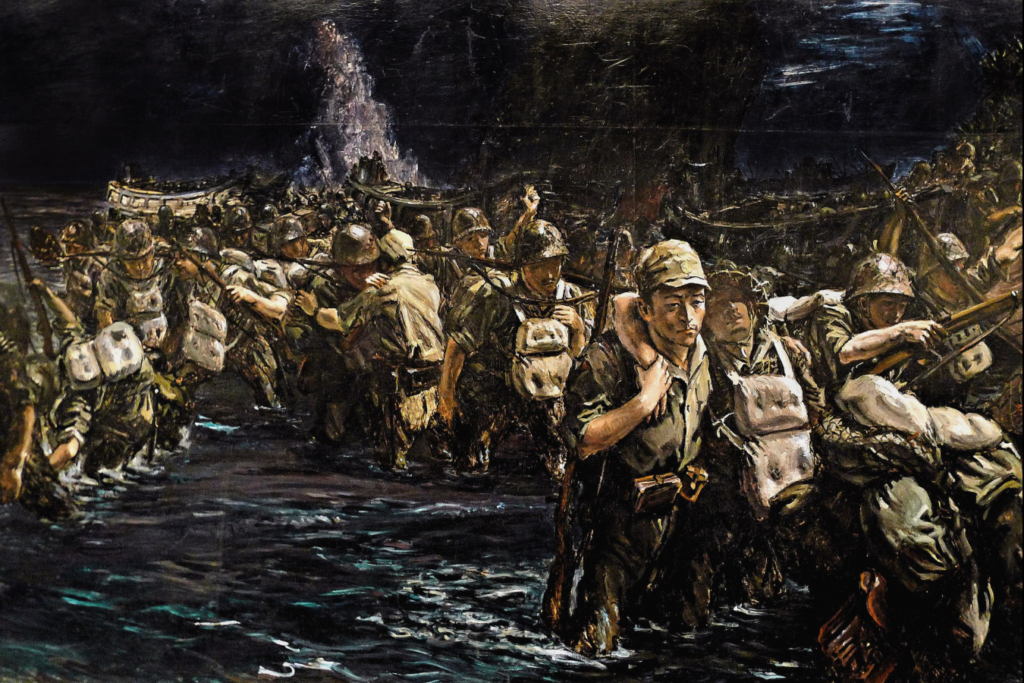
We return to Ark Royal’s Guadalcanal for the second part of the AAR. In the first part, I managed to establish a foothold on the island, rebuild the airfield and destroy 2 of the 6 Japanese depots (“camps”), but constant Japanese attacks drained my manpower and I was forced on the defensive for 10 turns until, finally, I received massive reinforcements turn 25. I had 91 force points shared between 12 surviving Marines units, so less than 8 force points each on average. The 57 reserve points will allow me to push that number to more than 12!
In any case, it has been a while, so a few recaps below:
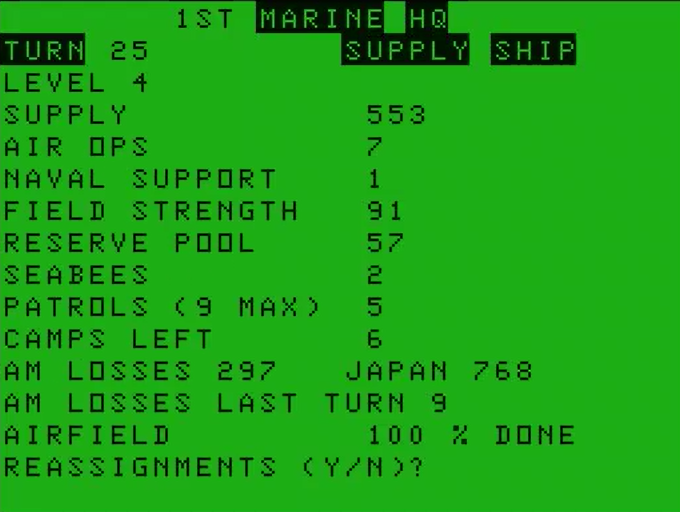
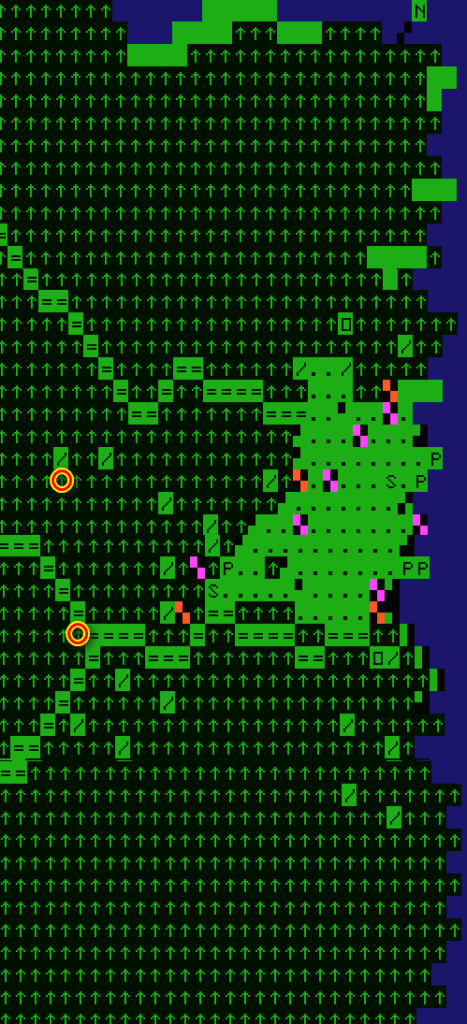
I added red circles at the known locations of two Japanese depots.
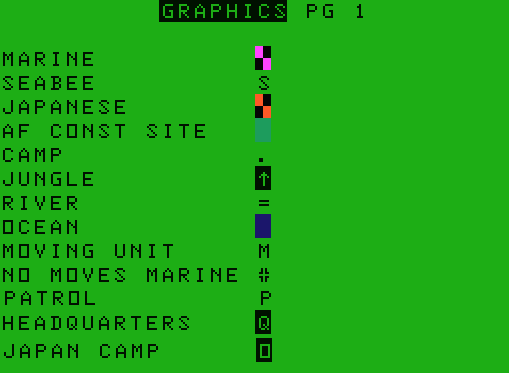
Raid to the East (turns 25-34)
I need to focus on destroying the depots, so instead of allocating replacements equally between all my units, I strengthen as much as possible three elite units (units with 5 experience – the maximum possible). I also turn one of them into a “patrol” which has half-strength but maximum mobility. The plan is simple: the patrol will beeline for the depots with massive air support, while the normal units will shield the patrol from counter-attacks. As for the rest of the replacements, they will be used to buff a few pivotal defensive units.
And off we go. High-experience and high strength points do wonders, with the Japanese attackers receiving up to 10 losses by battle!
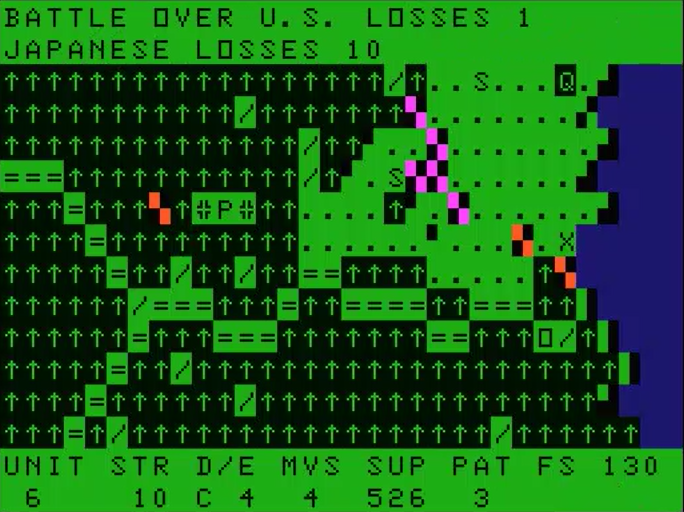
With the planes scouting the way, my patrol approaches the river depot. I thought it was defenceless but, unexpectedly, a Japanese unit returned (or spawned) on the depot between the moment my plane checked it and the moment my patrol arrived:
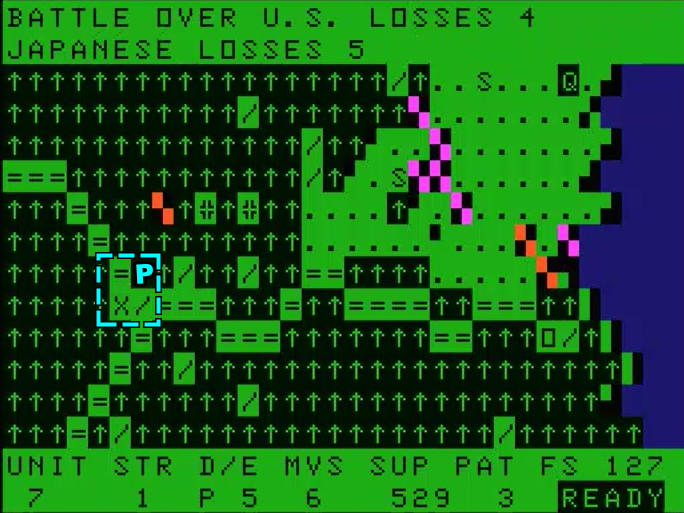
One turn later, after more air strikes, my patrol captures the 3rd Japanese depot.
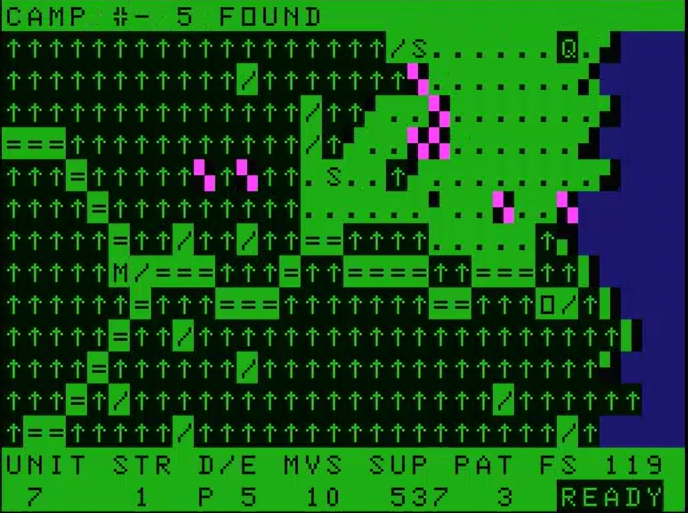
I receive some decent reinforcements turn 30 (25 reserve points), but I feel I still have enough juice in my raid to move directly to the fourth Japanese depot and capture it:
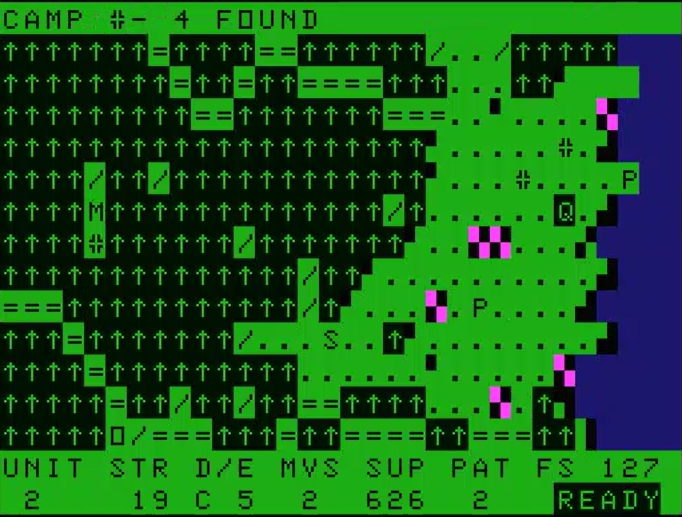
It is now turn 34, and I have 4 more enemy depots to capture – and only meagre reinforcements this time:
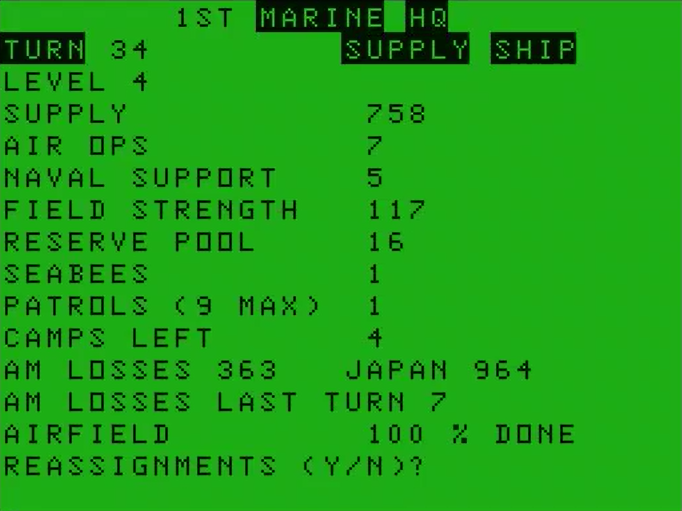
Holding the line – again (turns 35-40)
In a back and forth that is now usual in Guadalcanal, the Japanese decide to come back in force from the North and the South. At least, I don’t need to defend the West, because all the camps in that direction have been neutralized:
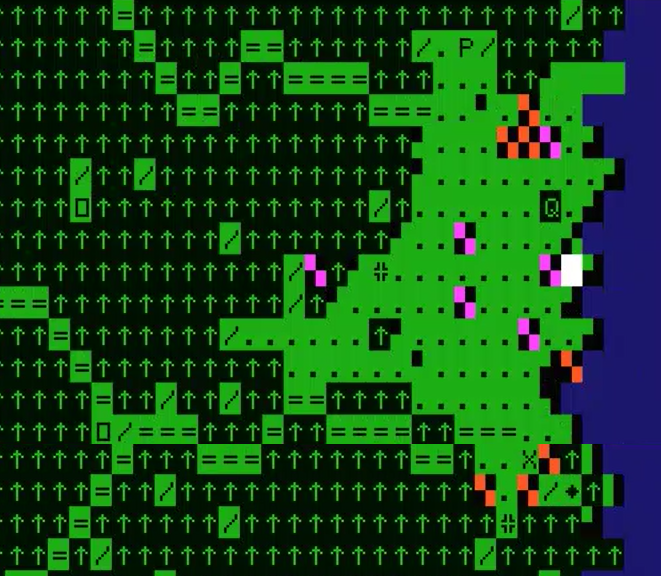
My defensive units are overwhelmed, which means I must use those badly depleted units I had in the middle of my camp. I lose one of them, but eventually the Japanese are pushed back, in large part because I had accumulated many naval supports and even the most depleted unit can direct this on the Japanese.
Disasters (turns 41-49)
At this point, I know the drill:
- Detect an enemy depot with a combination of [I]intelligence and air [S]earch,
- Send a small cadre of units supported by a massive air force,
- Reach the camp,
- Reinforce and repeat.
The game itself supports this approach, by giving me another massive wave of reinforcements turn 40. In addition to that, I replenish my Seabees and receive +1 air ops forever (as I do every 20 turns).
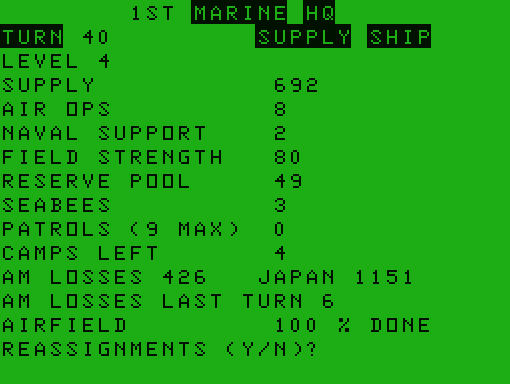
Intelligence reported an enemy depot in the North slightly West of the coastline, and another one South near the coast – individual reports are not very accurate, but several reports give me a good general idea of where to send my planes, and indeed I soon find a depot in the North:
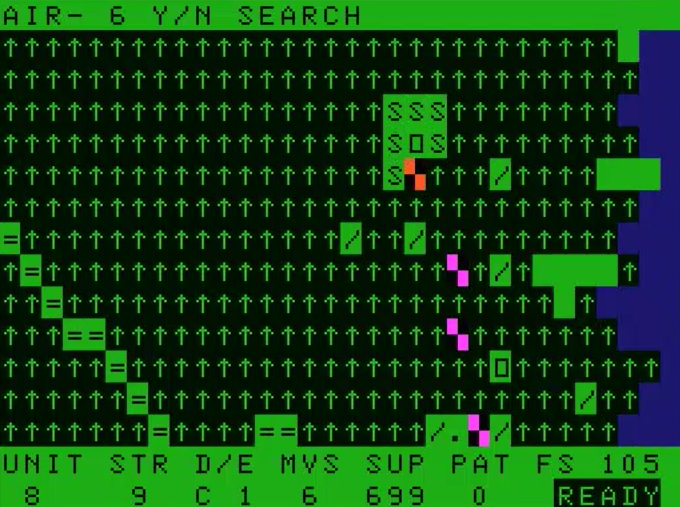
In the South, I regrouped a much larger force waiting for my scouts to report the location of a Japanese depot, but I can’t seem to find it – even after enlarging the perimeter of my searches:
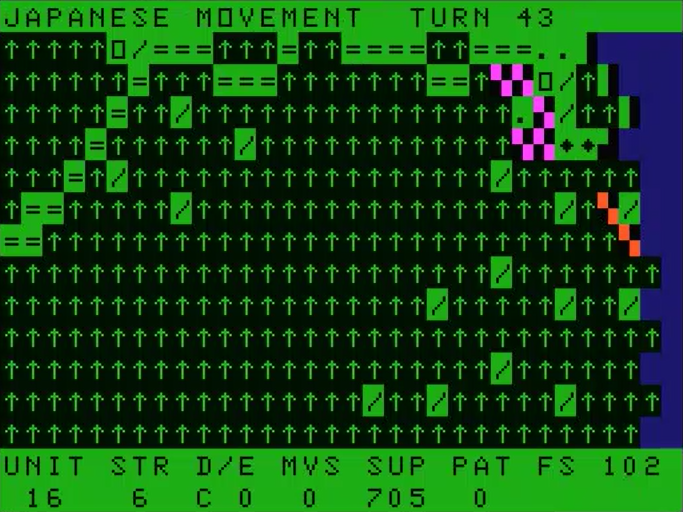
As I grow increasingly frustrated with my air searches, I consume more air missions in searches than I should. I don’t care about keeping a reserve for air superiority anyway; I have almost no units left in camp and the occasional Japanese bombers have thoroughly missed so far – so much so that I reckoned the game had a “pity” system (a system that rigs the game in favour of the player) to avoid hitting the airfield too much.
I was wrong:
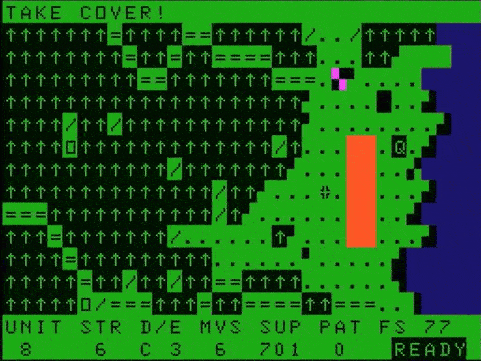
That’s not good! What’s worse is that my engineers are currently far away from the airfield, cutting through the jungle, so I need to rush them. Meanwhile, I have half the number of air missions I used to have, which means the Japanese bomb me a lot more.
It is now important to remember that in Guadalcanal enemy movement is peculiar: they move between your own movements, with usually one unit moving one square (sometimes they don’t move at all, sometimes they have 2 impulses in a row). And the fewer units the Japanese have, the more often the surviving units move as the pool of eligible units is smaller. And guess what? The Japanese are down to around 10 units according to intelligence… and two of them are now racing to my HQ, all while the bombers hit my airfield again and again:

If the Japanese reach my HQ, they will drain my supplies and my future replacements, so I can’t allow that. But what do I have to defend you ask? Well, my Seabees, which are not prime combat units, and who are not repairing the airfield when fending off starved Japanese.
The rest of the Japanese seem to be in the South aggressively attacking my Southern group and causing some significant damage because I can’t punish them from the air and I am all out of naval support – and yet I have to pull some of my units from that group to rush to the defence of the airfield. My losses are catastrophic!
The only silver lining is that I find one of the Northern depots, with intelligence immediately telling me that there is another nearby:
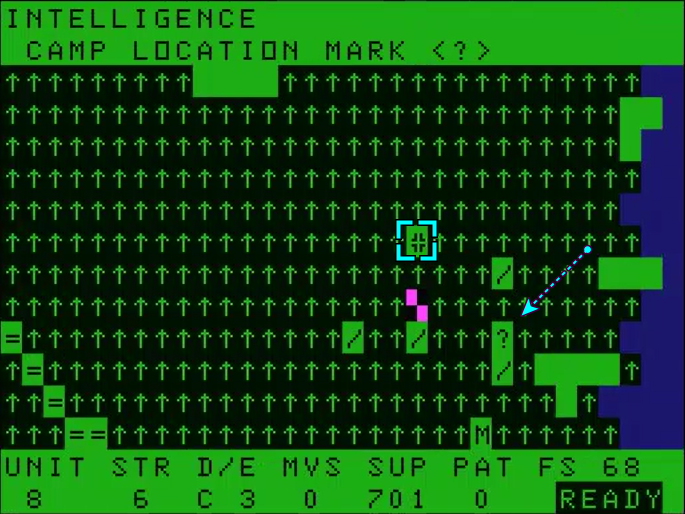
When the Japanese offensive finally runs out of steam, I’ve lost 4 combat units and one unit of Seabees. The rest of the Marines are not looking much better:
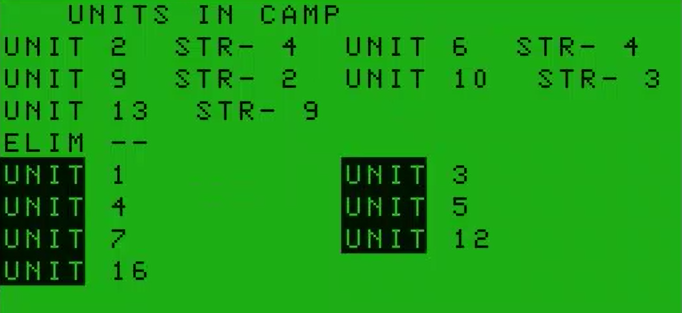
Fortunately, the war on the sea must have gone better, because the supply ship brings me more men than it ever did! I still have a chance!
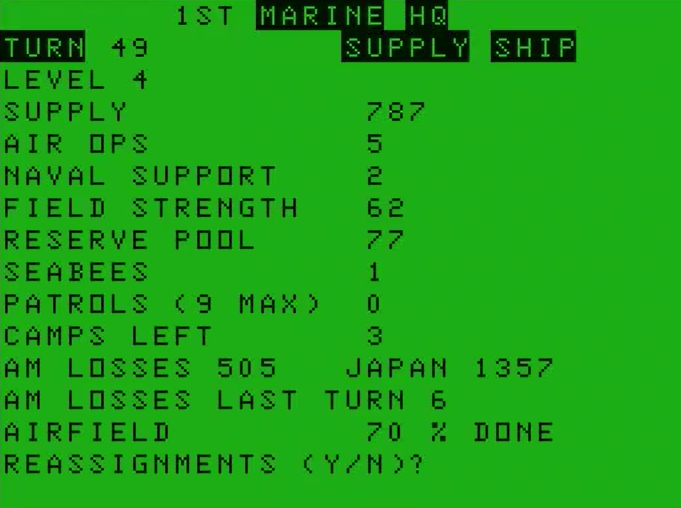
Alternate reality (turns 50-60+)
Well, the Japanese yelled their last Banzai, and they are down to 5 units.

On my side, I am now racing against the clock. It is over for a “decisive” victory (I would’ve had to win in fewer than 45 turns), but I can still achieve a “conditional” victory (fewer than 60 turns), or at worst a “marginal” victory (fewer than 75 turns).
I eventually find another Northern camp…
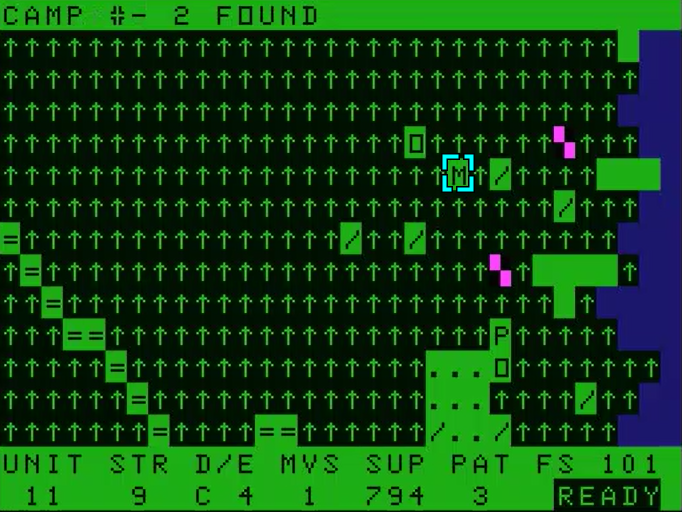
… but I still can’t find the Southern ones. They are not where it they are supposed to be according to intelligence. I spend more than one hour trying to be smart, requesting more intelligence, sending air searches in a systematic pattern and, as I found out to my dismay, fending off new full-strength fresh Japanese troops that soared their “total number” to 11. And yet, I can’t find any of those stupid depots! I eventually grow frustrated, move the game to warp speed, and go full stupid:
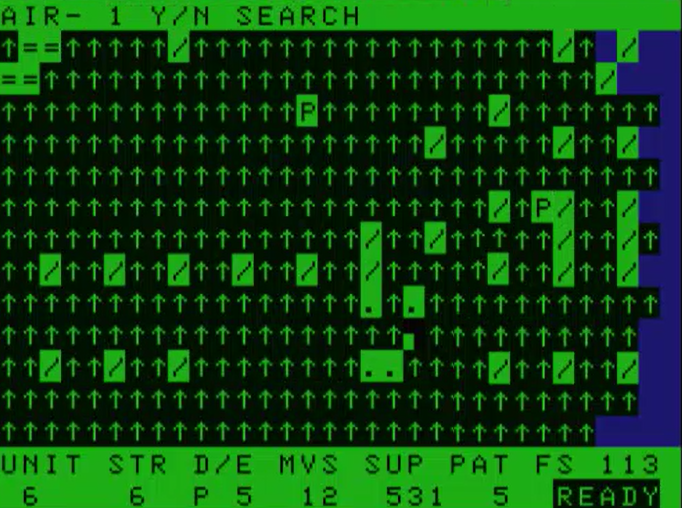
Nothing!
I start to wonder if the missing two depots might be in the middle of the sea, or maybe off-map. Speaking of off-map, I check whether the map can go further than it can scroll. I send a patrol to the border of the “scrollable” map and, what do you know, the map scrolls further. It scrolls for 2 more lines of jungles, and then enters bug world:
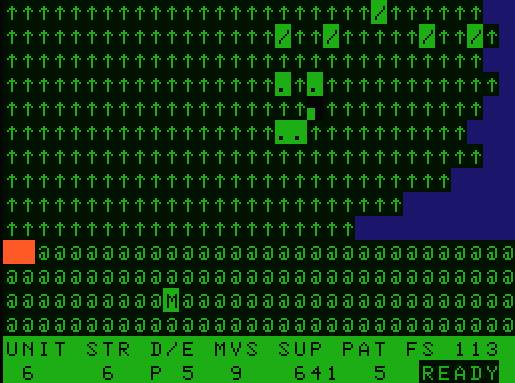
I comb all the new “jungle” squares, but still find nothing. There have been quite a few bugs already: patches of jungle being replaced in the middle of nowhere by “clear” terrain, letters which don’t signify anything appearing in some other places, so I reckon there is another bug that makes the game quite simply unwinnable.
Still, just in case, I send a patrol to the general area where the intelligence tells me one of the depots should be…
… well, I find it. Between two air searches that never revealed it.
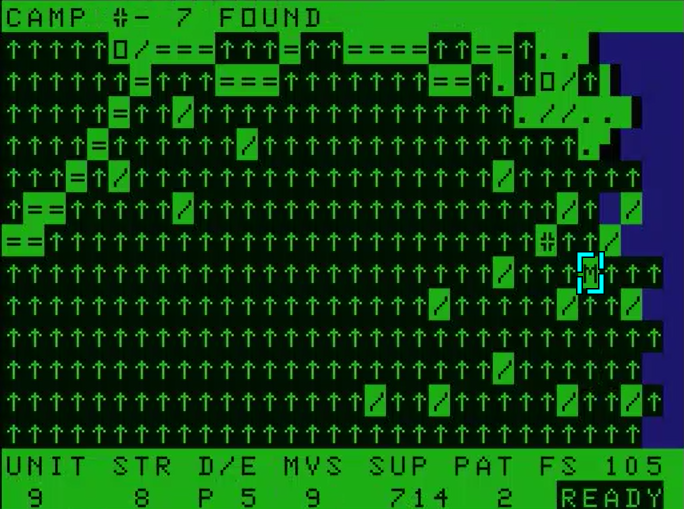
I reload one of my early saves to check (turn 8!), and I am not mistaken: air search never revealed the existence of this specific depot. The manual never hinted that air search could fail (“any Japanese camps (reverse ‘O’) or units (red checked) located in the 3 X 3 search pattern will briefly appear“) so it is a bug in my book. I reload to turn 50, which is when I had started to really push for the Southern depots.
The real (?) end (turns 50 – 56)
I am now armed with the knowledge that air searches are not 100% effective (and, to be fair, with the exact location of one of those depots). I easily cap the closest depot and then send patrols in the general area of the last intelligence report. I find my target on turn 56:
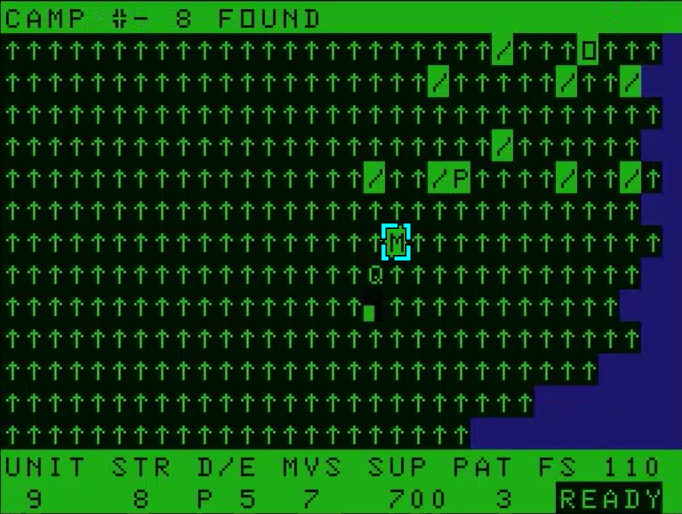
That’s a conditional victory:
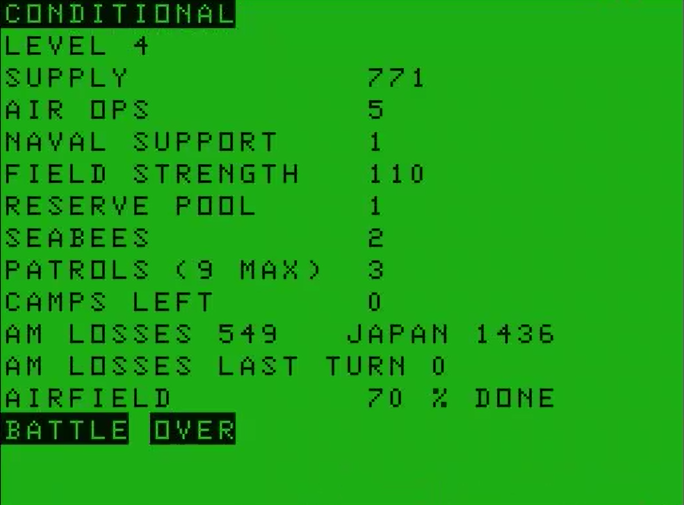
Do I deserve this victory? I am not sure. The manual made it clear that the invisible Japanese camps could only be a bug, but maybe I should have been more suspicious and sent a patrol in the general area where intelligence told me there was one. I would certainly have done that, I think, if I trusted the game and Ark Royal games. But if your games are riddled with bugs or design oversights, I am going to assume by default that the issue is with the game, and not with me.
Ratings & Reviews
Guadalcanal, by Philip Keller, published by Ark Royal Games, USA
Genre: Land operations
First release: April 1984 on Color Computer
Average duration of a campaign: More than 3 hours
Total time played: 5 hours
Complexity: Average (2/5)
Final Rating: Two-stars
Ranking at the time of review: 25/121
As with all the Ark Royal wargames, I could not piece up much about Guadalcanal – I could not even find a review for it. All I can say is that Philip Keller must have been happy with it, because it was one of his few games with a re-edition (1987 according to the manual), and the one he earmarked to be distributed in shareware – if you liked it Keller asked you to “make a contribution (no more than $10.00) to Ark Royal Games, POB 14806, Jacksonville, Fl, 32238.” Unfortunately, a quick internet check reveals that Ark Royal Games has moved, so I am not able to send the 10 dollars.
A. Presentation: Very poor. I forgive the lack of graphics for a game that represents well the campaign of Guadalcanal, but I cannot forgive the many bugs of all sorts.
B. UI, Clarify of rules and outcomes: Very poor. I am still upset at either Keller leaving a critical bug in the game or not being transparent about the real efficacy of air searches. Beyond this, a myriad of UI issues and inconsistencies – individually too small to cover – plague the game due to their sheer number. In addition to this, after having played a full campaign, I am still not sure about the role of the Japanese camps beyond being objectives: do they generate new units, or do they only refill existing units, and if the latter under which constraints?
C. Systems: Good. The game shines in this category. I am particularly impressed at the number of options that the game gives to the players, with most of them involving a sacrifice of some sort. For instance, let’s talk about the Marines:
- Marines can attack at close range, which is efficient but costly in strength points,
- Alternatively, they can use their mortars, which are much less efficient and drain supplies – it is an option I seldom used early on because in my test game I ran out of supplies and got paranoid about this,
- They can also do some intelligence, and the closest they are to the enemy the better the intelligence is (but then a unit close to the frontline could have done something more useful),
- They can order naval support – air support on the other hand is a free action,
- Finally, you have the option of turning them into patrols, making them much weaker, but incredibly mobile (12 movement points instead of 6, and no terrain penalty when moving),
Similarly, Seabees should certainly be allocated to the airfield in priority, but once it is built, you have the choice between clearing the jungle (which means they are going to take some time to return to the airfield if needed) or using them as weak combat units that you recover every 20 turns. As for your air assets, every air search or air attack you use increases the chance of a Japanese air raid on your base – and keep in mind that if your Seabees are far away from the airfield, you really, really don’t want a Japanese raid on your airfield.
At the strategic level, you have another layer of decisions: how to allocate the reinforcements, where to push and where to defend, but also when to push given the fact that the Japanese attack by waves and given the supply ship schedule, a schedule which can be perturbed if you lose air superiority, so another element to take into account.
I liked the fact that I could “change” the terrain, an option rare in this kind of game but which makes total sense in this context.
I feel the game is weaker at the “combat” level:
- no armour or special weapon – Seabees and the regular Marines fight in the same way, the only advantage of the regular units is that their maximum strength is much higher – at some point it gets a bit monotonous,
- only one terrain bonus (“behind a river”, which rarely happens) and no entrenchment either,
- weird “retreat” and “zone of control” behaviour, for instance the Japanese just waltz through your lines because they don’t always retreat after combat and can move several times in a row
D. Scenario design & balancing: Adequate. The scenario is well-designed, alternating moments where you go on the offensive and moments where you are trying to hold the line. Still, the game could have been much better with more diversified terrain (too much jungle, not enough rivers to make the difference).
The AI is not as good as I first thought: contrary to my first impression, it does not consistently retreat to refill its troops, what’s more likely is that depleted units are not selected by the AI for movement and keep retreating when attacked, so they disappear from sight. When there are a lot fewer units to choose from, the AI attacks with its depleted units, stupidly losing them.
The campaign was a bit too long: toward the end it felt as if the game forgot about the expectation it had created about Japanese behaviour and started creating enemy units out of thin air. I reached a point where I wanted to finish the game as soon as possible, and the last turns were about abusing the patrol mode and allocating all my air assets to air support. I liked the game, but I would never replay it.
E. Did I make interesting decisions? Every turn until almost the end, with almost every unit.
F. Final rating: Two stars. I was so frustrated with the “invisible depot” bug that I almost tagged the game “obsolete”, so I forced myself to wait a bit for the frustration to mellow before writing this review. Looking back, once you know about the issue you can consider it an impromptu feature (“the Japanese hid those depots particularly well“) and the combination of intelligence and patrol mode is efficient enough that you have a fall-back solution when air search fails. Therefore, I don’t think this bug should weigh too heavily against the game, which is otherwise original and well thought-out, as marred as it is by dry graphics, sub-par UX and a throng of odd bugs and game behaviours. It definitely activated my “just one last turn” neuron for a good chunk of the campaign.
Phil Keller was certainly a better designer than a coder, and I am looking forward to his next games. I am lucky: he released no fewer than 6 historic wargames in 1984!
5 Comments
As I was reading the AAR I was thinking that this game has enough good stuff in it that it could have passed for some modern indie/hobby wargame if the graphics were better. Plenty of options to choose and interesting decisions to make, strategic plans were put into action with good follow up, jungle was tamed – at least from were I was reading it all looked quite appealing!
It makes it so much more of a shame that the game has the “invisible depot” bug. I assume the depots spawn randomly each game to keep it interesting, but that bug makes it such a chore to find them.
Yet, I’m still somewhat tempted to give it a try – maybe I won’t run into that bug?
Also, hello! I’m new to your awesome website. I got hooked on it recently, after reading through your AAR of Eastern Front 1941 from Atari. Honestly, I don’t even know how I stumbled upon it, but it was such a fun read that it made me want to check out more. So now I’m slowly going through some select games (planning to catch up completely one day) and hoping to give few of them a try myself… I guess I get to the age where I get more and more interested in some grognard wargames (also born in the 80s;)
Anyway, thanks for your work Scribe!
P.S. Apart from fixing the bug, what do you think would make this game better? As it seemed you were enjoying yourself up until the last 20 or so turns.
Welcome!
Honestly, once you know about the “bug”, finding invisible camps becomes a normal feature. Intelligence gives you the approximate location (+/- 5 squares), multiple intelligence requests, if they detect the same camp, will quickly narrow down the location to only a few tiles. After that, you can use your patrols (12 movements/turn, even in jungle) to comb what’s left to cover. Of course, you need the Japanese to cooperate and not destroy your patrols.
What I would add to the game, if I did a modern rendition and besides bug fix/UX/art, would be:
– More information and more events related to the naval/air part of the campaign: massive raids from Rabaul, Japanese battleships shelling you at almost point range, memos on the arrival & location of Japanese reinforcements… and on the other hand, sometimes, significant support from the US naval assets or land bombers,
– More base customisation by the Seabees: ammo dumps for the planes or the ground troops, a second airfield, pillboxes, entrenchment, etc. It would force the player to make more choices on what to do with the Seabees and expand the area to defend. Let the player build a full-fledged base of operations!
– More diversified terrain (more river crossing, some hills & ridges (eg Mount Austen), depression, Japanese trenches and fortifications
– A slightly more diversified unit roster for both sides (artillery, tanks – even amphibious tanks for the Japanese!). The infantry should still represent 90% of the combat units.
– Better/deeper Japanese behaviour. Ideally, they build their own depots, develop their own bases of operations, probe, retreat,… If the player turtles too much, the Japanese will have every inch of terrain covered with traps, trenches and whatnot.
If the game could be made deeper while keeping the fluid alternation between attack and defence and force you to carve some of your always-too-few defenders for offensive action, it would be perfect.
Tell us when you test this game or another game, I am always looking for second opinions!
After figuring out proper CoCo emulation solution I gave the game a try today.
I can see how your additions would vastly improve the game – I wished I could entrench my troops in/near the camp and get some artillery going as I was getting pelted from both north & south pretty much from the beginning (after some recon I found it was because there were camps quite close). Instead I had to turtle in and spent like 10 turns just exchanging fire bit by bit (bunch of “each side loses 1 strength” results). Being able to take advantage of terrain or employ some more tactics would have been awesome.
Nonetheless, I still feel it’s a pretty good game, even though the way you control everything is a bit idiosyncratic. I’m just dipping my toe in computer wargames and I’m sure this is not that far off standard UI for a wargame of this vintage, but it took a while to get used to.
One thing I was surprised to find I enjoyed was the drastic fog of war. It made think how and where to “scout” and plan defenses for my camp. Made each turn much more “thinky” for me and I wish more wargames would do that. In most of the ones I played you can see the enemy from the start and you can plan accordingly. Any other wargames out there that really elevate this “unknown position” of the enemy?
Anyway, I will probably end my this run, as it seems I might be stuck exchanging fire with the enemy for another 10 turns and that’s no fun. Now that I know how to play (more or less), I will start a new game and give it proper try on the weekend.
Indeed, it is easy to have half the marines (all those who land North of the camp) pinned in combat by the Japanese. That’s why I did everything to bring back those units to camp asap. Easier said then done.
Early on, I feel it is easier to mostly defend (to inflict more damage), and then only counter-attack to rack up some kills and increase the experience level. Marines with 2 or 3 experience can do some significant damage, and you can start to really push back the Japanese, then expand the camp , …
I have not covered any game with such a drastic fog of war – and the fog of war is really what makes expanding the camp really important, given you want to know where the enemies are to point naval guns and attack planes on them. Still, for the [good] games I covered, I feel scouting is particularly important in Operation Whirlwind (easy to pick-up) and in Keating’s wargames (eg Germany 1985 – but hard to pick up).
Speaking of which, with fewer bugs and better art/UX, Guadalcanal would have ranked next to Roger Keating best “SSI-era” wargames.
Another victorious blog. Looking forward to the next one!